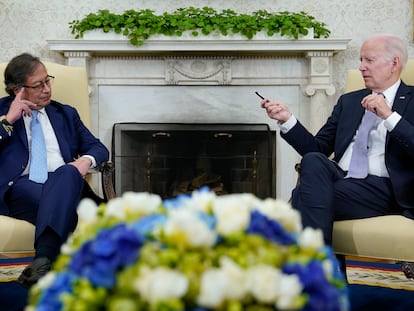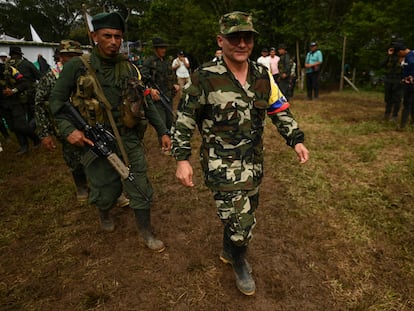Gustavo Petro returns to his revolutionary roots with Colombian government 2.0
The leftist leader has tired of negotiating with the traditional conservative parties over his reform plans and intends to mobilize his support base after a Cabinet reshuffle


The reflection in which Colombia has been looking at itself over the last few months has turned out to be a mirage. In a country marked by half a century of armed conflict and profound political polarization, the idea that a leftist ex-guerrilla could govern hand-in-hand with the traditional conservative parties has been short-lived. Nine months into Gustavo Petro’s term, the chips are down. While the president calls for mobilization among peasants and workers and attacks the neoliberal elites, the right-wing parties accuse him of threatening democracy, bypassing institutionality and wanting to perpetuate himself in power. In terms of politics, Colombia has become Colombia again. Only now, for the first time in the modern history of the country, it is the president who is inciting revolution.
Petro faces a significant challenge to “change the country” in four years, as he promised, but at least now he feels more comfortable. The coalition with which he formed his government briefly functioned at the beginning. After successfully pushing through tax reform in record time, Petro’s alliance with the political right began to crumble. The president began to despair: he has no time to lose and he needs results. It required decades in opposition for Petro to come to power and what his government achieves will mark the future of the left in a country with a long-standing conservative tradition.
The idea of a compromise government was too big for a nation where, despite huge social inequalities, Petro’s sense of urgency, his desire to turn the country around, is not shared in many sectors. The poverty rate in Colombia stands at over 40% but the macroeconomic reality paints a scenario of stability in which the business, political and economic elites feel comfortable, while the reduction of the unemployment rate has provided relief to the middle classes. A majority of Colombians remain convinced that reforms are necessary, but resistance to profound change is stronger.
Petro knows precisely what he wants to do — for years he has been designing reforms to transform the pillars of the state, shake up the health system, push through labor and pension reforms and to achieve a fairer distribution of land. He also wants to dismantle the ELN — the last active guerrilla organization in Latin America — bringing about unprecedented peace across the entire Colombian territory, while also changing the world paradigm of the war on drugs and spearheading a solution to the Venezuelan crisis. If that appears optimistic, it also explains why he finds negotiations with the entrenched political clans in Congress that undermine his reforms so exasperating. “Reforms are either made in the first year or they are not made at all,” he told EL PAÍS in an interview last June.
Now Petro has reverted to the Petro his supporters, the leftists who are accustomed to the streets and protests, want to see, those who were left cold by the pragmatic version of the president after he took office and placed the country’s economy and agrarian reform in the hands of moderate liberals. Last week, Petro replaced seven of his 19 Cabinet ministers, among them those who were part of the right-wing quota that assured him a majority in Congress. He has surrounded himself with leftists and former colleagues from his term as mayor of Bogotá (2012-2015). Now he must turn to the Liberal Party, which supports Petro’s coalition but is led by former president César Gaviria, with whom Petro shares an uneasy relationship, for the votes he needs to shore up his position in Congress and pursue his package of reforms. It will not be an easy task.
That is why Petro needs support from the streets. On Monday, to mark Labor Day, he called for the first major mobilization of his government. After the cabinet reshuffle he delivered a speech from the balcony of the presidential palace, addressing a crowd that cheered his every proclamation and booed his adversaries. This is where Petro is in his element: it was among the grassroots that his political stature grew.
In his hour-long diatribe, Petro rekindled the presidential candidate and opposition leader of the past. Attempting to derail his reforms could lead to “revolution” he warned while asking his supporters to mobilize and promote his work within the institutions. His intention is to come out on top in his war of words with Gaviria and win over the handful of liberals who could give him a majority in Congress, while young people, pensioners, peasants and the working-class cheer on his reforms. It is a familiar recipe with which Petro will attempt to refloat a presidential mandate in which he has cast dozens of nets without yet landing a big catch.
Sign up for our weekly newsletter to get more English-language news coverage from EL PAÍS USA Edition
Tu suscripción se está usando en otro dispositivo
¿Quieres añadir otro usuario a tu suscripción?
Si continúas leyendo en este dispositivo, no se podrá leer en el otro.
FlechaTu suscripción se está usando en otro dispositivo y solo puedes acceder a EL PAÍS desde un dispositivo a la vez.
Si quieres compartir tu cuenta, cambia tu suscripción a la modalidad Premium, así podrás añadir otro usuario. Cada uno accederá con su propia cuenta de email, lo que os permitirá personalizar vuestra experiencia en EL PAÍS.
¿Tienes una suscripción de empresa? Accede aquí para contratar más cuentas.
En el caso de no saber quién está usando tu cuenta, te recomendamos cambiar tu contraseña aquí.
Si decides continuar compartiendo tu cuenta, este mensaje se mostrará en tu dispositivo y en el de la otra persona que está usando tu cuenta de forma indefinida, afectando a tu experiencia de lectura. Puedes consultar aquí los términos y condiciones de la suscripción digital.
More information
Archived In
Últimas noticias
The new victims of the Republican war on Obamacare: Millions hit by soaring health insurance premiums
A country divided on migrant rights: Some US states expand protections while others restrict them
Venezuela authorizes the release of another 87 political prisoners
There is as much life left to discover on planet Earth as that which is already known
Most viewed
- David King, chemist: ‘There are scientists studying how to cool the planet; nobody should stop these experiments from happening’
- Reinhard Genzel, Nobel laureate in physics: ‘One-minute videos will never give you the truth’
- Oona Chaplin: ‘I told James Cameron that I was living in a treehouse and starting a permaculture project with a friend’
- Sinaloa Cartel war is taking its toll on Los Chapitos
- The Interoceanic Train, the Mexican alternative to the Panama Canal










































